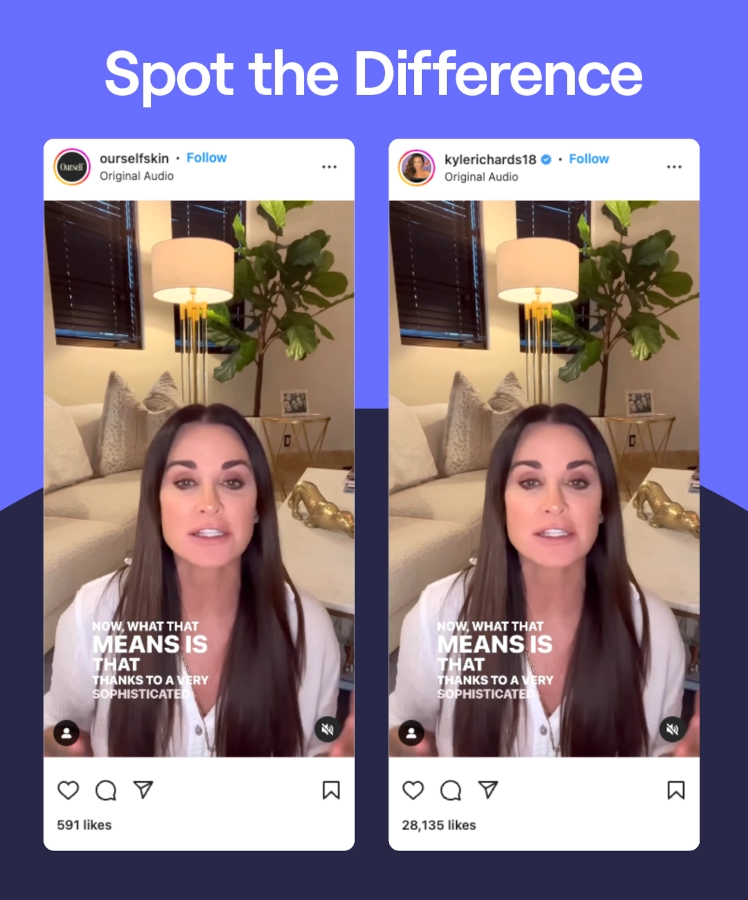When influencer content meets paid advertising, it creates marketing magic known as creator licensing. Once a well-kept secret known only to a few early adopters, creator licensing has become an essential strategy for brands looking to generate organic-looking content that comes with all the benefits of a traditional paid ad.
But as critical as the technique has become to brands, the approach is equally beneficial for their creator partners. By fully understanding the practice and how to execute it, you’ll be ready to make a pitch to your influencer team and start racking up conversions on licensed posts right away.
What is creator licensing?
Creator licensing is an influencer marketing strategy where content creators give advertising permissions (license) to brand partners to run ads through their social media handles.
Since the posts run as paid ads, brands have slightly more control over the posted content. They can add calls to action, make edits, and even leverage the influencer’s audience data to get the content in front of their ideal customers.
Licensed posts also typically perform better than traditional paid ads from owned channels because the content feels far more natural and speaks directly to a creator’s audience.

The above graphic is an example of a creator licensing partnership between Ourself Skincare and celebrity influencer Kyle Richards. The content is exactly the same for each, but there are a few key differences in performance:
- Larger reach – By licensing this post on Kyle Richards’ account, the brand gained access to her 4.9 million followers as opposed to the 37,000 people who follow Ourself Skincare’s account.
- More engagement – As a result of the larger audience, the same post generated more than 27,000 engagements on the creator’s account than on its owned channel.
- More organic – Users expect to see ads for new products from a branded account. But the licensed post from the creator feels far more organic and is more likely to cause someone to stop and pay closer attention to the content.
How do I start a creator licensing campaign?
Facebook and Instagram
To start a creator licensing campaign on Facebook and Instagram, you’ll need your influencer to grant you access to their Business Manager account through the Meta Business Suite. Remember, your creator must have their Facebook and Instagram accounts linked to Business Manager before you can run ads on their handles.
Once your creator gives you access, their Facebook and Instagram accounts will be available in Facebook’s Ads Manager. You will then be able to create influencer ads through feed posts, stories, reels, carousels, etc.
TikTok
For creator licensing on TikTok, ensure your creator has enabled “ad authorization” before you begin. They can find this by tapping the three dots on their “Me” page and navigating to the “Privacy” tab.
Creator licensing on TikTok can only occur with already published content. Once you and your influencer agree on a piece of content to license, have them generate a code from within the “Ad Authorization” tab. Once you have the code, you can start promoting the video via TikTok Ads.

Why make the switch from influencer whitelisting?
Historically, “influencer whitelisting” has been the most common name for creator licensing. But recent DEI initiatives have brought to light a number of outdated words and phrases that present opportunities to switch to more inclusionary language.
One of the most glaring examples of language used in the marketing industry is using the colors “white” and “black” to refer to something positively or negatively. In this case, whitelisting has a positive connotation as creators are “allowing” brands to do something, while a term like “blacklisting” has obvious restrictive qualities.
Making these language adjustments might take some getting used to for some. But the seemingly small shift could go a long way in eliminating implicit bias and creating a more inclusive environment for your creator partners.
What are the benefits of creator licensing?
Benefits to the brand
More targeted audiences
Creator licensing allows you to step outside the audience you’ve curated on your owned channels and reach your influencer’s more attentive and engaged followers. Plus, with access to your creator’s data, you can build lookalike audiences and target users similar to their existing fans.
More organic-looking content
Users can immediately identify product posts on a brand’s owned channel as an ad. But seeing the same promotion on a creator’s channel feels far more natural. It also adds an element of social proof for the product when it comes from a creator whose audience knows they won’t endorse anything that won’t add value to their lives.
Improved engagement
People engage with people—not companies. Creator licensing helps move the conversation into an environment where users can have an honest discussion about a product or service. As a result, brands have an opportunity to share their story and nurture the human element needed to form long-term relationships with consumers.
Strengthen relationships with creators
One of the most important parts of influencer marketing is treating your creators like trusted partners, not transactions. Inviting them to collaborate via creator licensing is a great show of faith that you trust your influencers and are willing to put dollars behind their content.
Benefits to the creator
Extended reach
With brands building lookalike audiences, creators also benefit from extending their reach to new viewers. This added boost gives influencers the perfect opportunity to add more like-minded individuals to their online network.
Less work
Creator licensing partnerships give creators one less thing to worry about. With the brand focused on the technical side of things, influencers can reap the benefits of the power of data while remaining solely focused on generating quality content.
More earning potential
Creator licensing is profitable for all influencers, but the added exposure the strategy provides makes it even more ideal for those working on commission. Helping your creators get paid is always positive for keeping your talent happy and your relationships strong.
More effective content
Amplified posts mean more data to analyze. By tracking and reporting the results of each piece of content, brands and influencers can make any necessary tweaks that let them tailor the most effective content for their audiences.
Best practices for successful creator licensing
Build trust.
Granting brands access to their account might seem a little scary to some influencers, so building trust is essential. Whether you’re partnering with a newer influencer or one with whom you already have a strong working relationship, take the time to explain creator licensing in full and answer any questions to make them feel as comfortable with the process as possible.
Take a ‘hands-off’ approach.
Just because you’re putting dollars behind the posts doesn’t mean you get to dictate the content. Give your influencers creative freedom to produce the kind of content proven to resonate with their audience. Creator licensing should seem as natural as possible, so don’t try to reinvent the wheel.
Automate whenever possible.
Though effective, creator licensing can be time-consuming. With that in mind, keep an eye out for tasks you can streamline. GRIN’s Creator Management platform is a lifesaver for influencer marketing managers looking to eliminate busy work and automate menial tasks like creator outreach and communication, generating affiliate links, product seeding, and more.
Continuously monitor campaign performance.
You will have a bundle of useful data at your disposal after each post, so keep a close eye on how everything performs. Work with your influencers to tweak content that doesn’t live up to your standards and iterate the posts with the highest conversion rates.
Include a strong CTA.
Your influencers will produce compelling content that engages their audience, but make sure they wrap everything up with a strong CTA. This is where your marketing chops really come into play with a chance to take captivated viewers and turn them into customers.
Put everything into writing.
Create a written contract so everyone knows exactly what their expectations are. This will keep the whole team on the same page throughout the campaign and add accountability for both the brand and creator.
Work with creators of all sizes.
There are unique advantages for small and large creators. Smaller influencers generally have higher engagement rates and access to more niche audiences. Macro influencers, on the other hand, are great for blasting your message to a bigger audience. Consider working with both to complement your marketing mix.
Use multiple creators
It’s best to start with at least four to five different creators so you have different personalities, styles, and handles to use in your ad account. Once you determine what works best, you can build out your strategy with influencers creating content similar to that of your highest performers.
How to select the right influencers for creator licensing
How much ‘influence’ does my influencer have?
Even though the paid dollars behind your licensed posts will help get your content in front of the right people, you still want to make sure your creator’s existing audience is of good quality. Consider running an influencer audit to ensure they have a high engagement rate, audience credibility score, and other indicators of a natural, engaged following.
Does the influencer fit my mission and values?
Regardless of campaign type, the best influencers to partner with are those whose personas align with your brand’s identity and messaging. Once you’ve found them, make sure they have used (and love) your products and are on board with your brand’s mission and values before entering a creator licensing agreement. Otherwise, you risk running an inauthentic campaign that could turn consumers—and your influencer’s audience—off completely.
How does the influencer engage with their audience?
Followers’ comments on your influencer’s posts are a good sign of high engagement, but you also want to make sure the conversation isn’t always one-sided. Look for influencers who regularly interact with their fans in the comments or through Q&As. It doesn’t have to be much—sometimes, just a few words go a long way in building a stronger connection.
Is the influencer easy to work with?
Creator licensing agreements can become a hassle if your partners are difficult to work with. Influencer discovery and recruitment tools help you find multiple high-quality influencers in even the most obscure niches, so you don’t have to waste time with those who might not act in good faith.
What are the challenges of creator licensing?
Granting permissions
This is generally the No. 1 pain point for brands starting their creator licensing journey. The manual process requires each creator to grant you access to their account individually. Plus, if they are also new to creator licensing, you will likely have to walk them through the additional process of setting up a Business Manager account. Even after you’ve ironed out your onboarding process, you’re likely still looking at multiple calls/emails to get your permissions in order.
Potential oversaturation
Because brands can target anyone through creator licensing, there is always a risk of pestering audiences with oversaturation. This is why creators have to feel comfortable with the brands they partner with and why brands should only seek out partners whose followers align with their ideal customer persona.
Limited oversight from the creator
Since the brand is running ads from its own ad account, creators won’t always be able to see exactly what is happening with their content and likeness. This is yet another reason why trust and communication are so critical for a successful creator licensing partnership.
Key takeaway: Paid ads and influencer marketing is the perfect marriage for social media magic.
Creator licensing combines two tried and true strategies into one marketing juggernaut. As you look for ways to scale your influencer program, consider the approach your new not-so-secret weapon.
Your top-performing influencers will likely be open to a well-thought-out creator licensing proposition. When done right, the results will be mutually beneficial.
Learn more about influencer marketing: Influencer Marketing 101

















